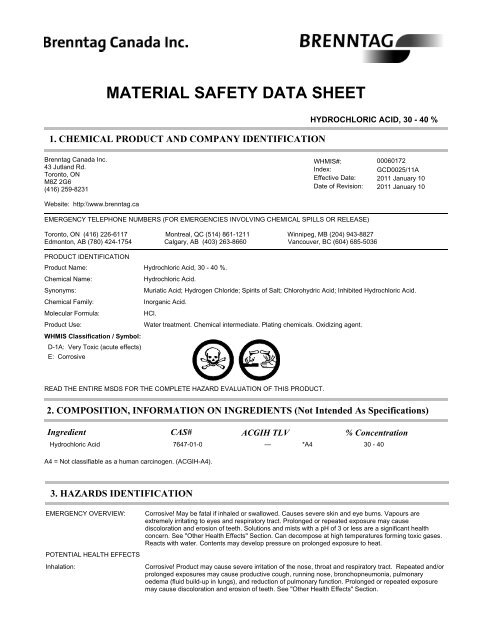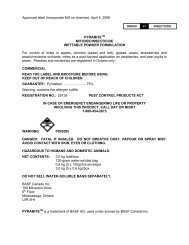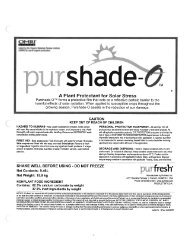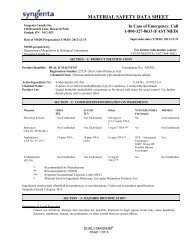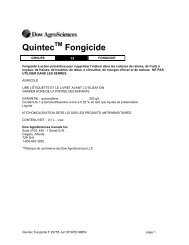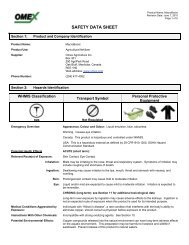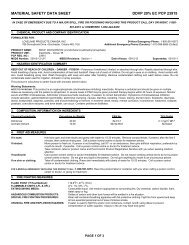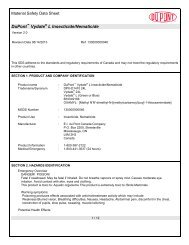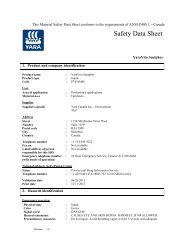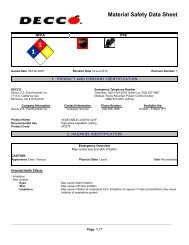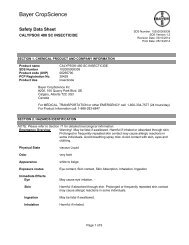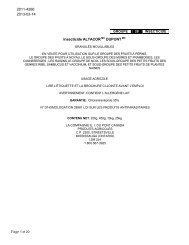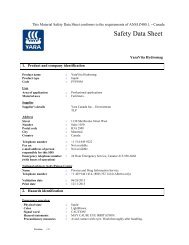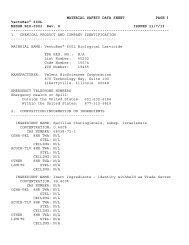Hydrochloric Acid msds english.pdf - Bartlett.ca
Hydrochloric Acid msds english.pdf - Bartlett.ca
Hydrochloric Acid msds english.pdf - Bartlett.ca
You also want an ePaper? Increase the reach of your titles
YUMPU automatically turns print PDFs into web optimized ePapers that Google loves.
MATERIAL SAFETY DATA SHEET1. CHEMICAL PRODUCT AND COMPANY IDENTIFICATIONHYDROCHLORIC ACID, 30 - 40 %Brenntag Canada Inc.43 Jutland Rd.Toronto, ONM8Z 2G6(416) 259-8231WHMIS#: 00060172Index:Effective Date:GCD0025/11A2011 January 10Date of Revision: 2011 January 10Website: http:\\www.brenntag.<strong>ca</strong>EMERGENCY TELEPHONE NUMBERS (FOR EMERGENCIES INVOLVING CHEMICAL SPILLS OR RELEASE)Toronto, ON (416) 226-6117 Montreal, QC (514) 861-1211 Winnipeg, MB (204) 943-8827Edmonton, AB (780) 424-1754 Calgary, AB (403) 263-8660 Vancouver, BC (604) 685-5036PRODUCT IDENTIFICATIONProduct Name:<strong>Hydrochloric</strong> <strong>Acid</strong>, 30 - 40 %.Chemi<strong>ca</strong>l Name:<strong>Hydrochloric</strong> <strong>Acid</strong>.Synonyms:Muriatic <strong>Acid</strong>; Hydrogen Chloride; Spirits of Salt; Chlorohydric <strong>Acid</strong>; Inhibited <strong>Hydrochloric</strong> <strong>Acid</strong>.Chemi<strong>ca</strong>l Family:Inorganic <strong>Acid</strong>.Molecular Formula:HCl.Product Use:Water treatment. Chemi<strong>ca</strong>l intermediate. Plating chemi<strong>ca</strong>ls. Oxidizing agent.WHMIS Classifi<strong>ca</strong>tion / Symbol:D-1A: Very Toxic (acute effects)E: CorrosiveREAD THE ENTIRE MSDS FOR THE COMPLETE HAZARD EVALUATION OF THIS PRODUCT.2. COMPOSITION, INFORMATION ON INGREDIENTS (Not Intended As Specifi<strong>ca</strong>tions)Ingredient CAS# ACGIH TLV % Concentration<strong>Hydrochloric</strong> <strong>Acid</strong> 7647-01-0 — *A430 - 40A4 = Not classifiable as a human <strong>ca</strong>rcinogen. (ACGIH-A4).3. HAZARDS IDENTIFICATIONEMERGENCY OVERVIEW:POTENTIAL HEALTH EFFECTSInhalation:Corrosive! May be fatal if inhaled or swallowed. Causes severe skin and eye burns. Vapours areextremely irritating to eyes and respiratory tract. Prolonged or repeated exposure may <strong>ca</strong>usediscoloration and erosion of teeth. Solutions and mists with a pH of 3 or less are a signifi<strong>ca</strong>nt healthconcern. See "Other Health Effects" Section. Can decompose at high temperatures forming toxic gases.Reacts with water. Contents may develop pressure on prolonged exposure to heat.Corrosive! Product may <strong>ca</strong>use severe irritation of the nose, throat and respiratory tract. Repeated and/orprolonged exposures may <strong>ca</strong>use productive cough, running nose, bronchopneumonia, pulmonaryoedema (fluid build-up in lungs), and reduction of pulmonary function. Prolonged or repeated exposuremay <strong>ca</strong>use discoloration and erosion of teeth. See "Other Health Effects" Section.
<strong>Hydrochloric</strong> <strong>Acid</strong>, 30 - 40 %WHMIS Number : 00060172Page 2 of 9Skin Contact:Skin Absorption:Eye Contact:Ingestion:Other Health Effects:Brenntag Canada Inc.Date of Revision: 2011 January 10Corrosive! Burns <strong>ca</strong>n occur if not promptly removed. Concentrated solutions may <strong>ca</strong>use pain and deepand severe burns to the skin. Prolonged and repeated exposure to dilute solutions often <strong>ca</strong>usesirritation, redness, pain and drying and cracking of the skin. Toxic effects may be delayed. Avoid handlingwhen the skin is moist, wet or abraded.Skin absorption is a secondary concern to the continual destruction of tissue while the product is incontact with the skin. Prolonged or wide spread skin contact may result in the absorption of potentiallyharmful amounts of material.Extremely corrosive! This product <strong>ca</strong>uses corneal s<strong>ca</strong>rring and clouding. Glaucoma, <strong>ca</strong>taracts andpermanent blindness may occur.Corrosive! This product <strong>ca</strong>uses severe burning and pain in the mouth, throat and abdomen. Vomiting,diarrhea and perforation of the esophagus and stomach lining may occur. Prolonged or repeatedexposure may <strong>ca</strong>use discoloration and erosion of teeth.Corrosive effects on the skin and eyes may be delayed, and damage may occur without the sensation oronset of pain. Strict adherence to first aid measures following any exposure is essential.May <strong>ca</strong>use ulcers of the upper respiratory tract and pulmonary oedema. Pulmonary oedema is the buildupof fluid in the lungs that might be fatal. Symptoms of pulmonary oedema, such as shortness ofbreath, may not appear until several hours after exposure and are aggravated by physi<strong>ca</strong>l exertion. (4)4. FIRST AID MEASURESFIRST AID PROCEDURESGeneral Guidelines:Inhalation:Skin Contact:Eye Contact:Ingestion:Prompt removal of the material and obtaining medi<strong>ca</strong>l attention are essential for all contact. Remove allcontaminated clothing and immediately wash the exposed areas with copious amounts of water.Continue the flushing during transportation to the emergency department. Corrosive effects may bedelayed (up to 72 hours), and damage may occur without the sensation or onset of pain. Contact lo<strong>ca</strong>lpoison control centre for further guidance.Move victim to fresh air. Give artificial respiration ONLY if breathing has stopped. Give <strong>ca</strong>rdiopulmonaryresuscitation (CPR) if there is no breathing AND no pulse. Oxygen administration may be beneficial inthis situation but should only be administered by personnel trained in its use. Obtain medi<strong>ca</strong>l attentionIMMEDIATELY.Prompt removal of the material from the skin is essential. Remove all contaminated clothing andimmediately wash the exposed areas with copious amounts of soap and water for a minimum of 30minutes or up to 60 minutes for criti<strong>ca</strong>l body areas. Immerse the exposed part immediately in ice waterto relieve pain and to prevent swelling and blistering. Place cold packs, ice or wet cloths on the burnedarea if immersion is not possible. Cover the exposed part with a clean, preferably sterile, lint-freedressing. Obtain medi<strong>ca</strong>l attention IMMEDIATELY and monitor breathing and treat for shock for severeexposure.Immediately flush eyes with running water for a minimum of 30 minutes, preferably up to 60 minutes.Hold eyelids open during flushing. If irritation persists, repeat flushing. Do not transport victim until therecommended flushing period is completed unless flushing <strong>ca</strong>n be continued during transport.Do not attempt to give anything by mouth to an unconscious person. IMMEDIATELY contact lo<strong>ca</strong>l PoisonControl Centre. If victim is alert and not convulsing, rinse mouth out and give 1 to 2 glasses of milk.Water may be used if milk is not available but it is not as effective. If spontaneous vomiting occurs, havevictim lean forward with head down to avoid breathing in of vomitus, rinse mouth and administer moremilk or water. IMMEDIATELY transport victim to an emergency facility.
<strong>Hydrochloric</strong> <strong>Acid</strong>, 30 - 40 %WHMIS Number : 00060172Page 3 of 9Note to Physicians:Brenntag Canada Inc.Date of Revision: 2011 January 10Due to the severely irritating or corrosive nature of the material, swallowing may lead to ulceration andinflammation of the upper alimentary tract with hemorrhage and fluid loss. Also, perforation of theesophagus or stomach may occur, leading to mediastinitis or peritonitis and the resultant compli<strong>ca</strong>tions.(3) Mucosal injury following ingestion of this corrosive material may contraindi<strong>ca</strong>te the induction ofvomiting in the treatment of possible intoxi<strong>ca</strong>tion. Similarly, if gastric lavage is performed, intubationshould be done with great <strong>ca</strong>re. If oral burns are present or a corrosive ingestion is suspected by thepatient's history, perform esophagoscopy as soon as possible. Scope should not be passed beyond thefirst burn be<strong>ca</strong>use of the risk of perforation.This product contains materials that may <strong>ca</strong>use severe pneumonitis if aspirated. If ingestion hasoccurred less than 2 hours earlier, <strong>ca</strong>rry out <strong>ca</strong>reful gastric lavage; use endotracheal cuff if available, toprevent aspiration. Observe patient for respiratory difficulty from aspiration pneumonitis. Give artificialresuscitation and appropriate chemotherapy if respiration is depressed.Do not attempt to neutralize the acid with weak bases since the exothermic reaction may extend thecorrosive injury. Do not use buffering agents (e.g., antacids) they produce signifi<strong>ca</strong>nt exothermicreactions without signifi<strong>ca</strong>ntly altering the pH. Since reexposure of the mucosa to acid is harmful, be<strong>ca</strong>reful to avoid further vomiting and limit fluid to one to two glasses for an adult. (3)Medi<strong>ca</strong>l conditions that may be aggravated by exposure to this product include neurologi<strong>ca</strong>l,<strong>ca</strong>rdiovascular and skin disorders, diseases of the skin, eyes or respiratory tract.5. FIRE-FIGHTING MEASURESFlashpoint (°C)Non-combustible (does notburn).Flammability Class (WHMIS):Hazardous CombustionProducts:Unusual Fire or ExplosionHazards:Sensitivity to Mechani<strong>ca</strong>l Impact:Rate of Burning:Explosive Power:Sensitivity to Static Discharge:EXTINGUISHING MEDIAFire Extinguishing Media:FIRE FIGHTINGINSTRUCTIONSInstructions to the Fire Fighters:Fire Fighting ProtectiveEquipment:Flammability Limits in Air (%):AutoIgnitionTemperature (°C) LEL UELNot appli<strong>ca</strong>ble. Not appli<strong>ca</strong>ble. Not appli<strong>ca</strong>ble.Not regulated.Thermal decomposition products are toxic and may include chlorine and hydrogen chloride.When heated, hydrogen chloride gas is liberated. Avoid direct contact of this product with water as this<strong>ca</strong>n <strong>ca</strong>use a violent exothermic reaction. Reacts with most metals to produce hydrogen gas which couldmake an explosive mixture with air.Not expected to be sensitive to mechani<strong>ca</strong>l impact.Not available.Not available.Not expected to be sensitive to static discharge.Use <strong>ca</strong>rbon dioxide, foam or dry chemi<strong>ca</strong>l media. If only water is available, use it in the form of a fog.Use water spray to cool fire-exposed containers or structures. Use water spray to disperse vapours.Isolate materials that are not involved in the fire and protect personnel. The heat from a fire <strong>ca</strong>n <strong>ca</strong>use abuild-up of pressure inside the containers which may rupture. Cool containers with flooding quantities ofwater until well after the fire is out. (4) Spilled acid may <strong>ca</strong>use floors and contact surfaces to be comeslippery.Use self-contained breathing apparatus and protective clothing. Protective clothing for skin and eyeprotection should be worn to protect against corrosive materials.6. ACCIDENTAL RELEASE MEASURESInformation in this section is for responding to spills, leaks or releases in order to prevent or minimize the adverse effects on persons,property and the environment. There may be specific reporting requirements associated with spills, leaks or releases, which change fromregion to region.
<strong>Hydrochloric</strong> <strong>Acid</strong>, 30 - 40 %WHMIS Number : 00060172Page 4 of 9Containment and Clean-UpProcedures:Brenntag Canada Inc.Date of Revision: 2011 January 10See Section 13, "Deactivating Chemi<strong>ca</strong>ls". In all <strong>ca</strong>ses of leak or spill contact vendor at EmergencyNumber shown on the front page of this MSDS. Wear protective clothing. Do not use combustiblematerials such as sawdust as an absorbent. Spilled acid may <strong>ca</strong>use floors and contact surfaces to become slippery. Collect product for recovery or disposal. For release to land, or storm water runoff,contain discharge by constructing dykes or applying inert absorbent; for release to water, utilizedamming and/or water diversion to minimize the spread of contamination. Ventilate enclosed spaces.Notify appli<strong>ca</strong>ble government authority if release is reportable or could adversely affect the environment.7. HANDLING AND STORAGEHANDLINGHandling Practices:Ventilation Requirements:Other Pre<strong>ca</strong>utions:STORAGEStorage Temperature (°C):Ventilation Requirements:Storage Requirements:Special Materials to be Used forPackaging or Containers:Use normal "good" industrial hygiene and housekeeping practices. Containers exposed to heat may beunder internal pressure. These should be cooled and <strong>ca</strong>refully vented before opening. A face shield andapron should be worn. When diluting, add this material/product to water in small amounts to avoidspattering. Never add water to this material/product. Add small quantities of this material slowly to largequantities of water, stirring constantly all the while. Constant stirring is necessary to avoid concentrationof the product at the bottom of the mix vessel. Such concentration of the product may result in a violentexotherm with boiling of the liquid resulting in splashing, spattering or a violent eruption of a highlycorrosive solution if the addition is too rapid or without sufficient stirring.See Section 8, "Engineering Controls".Use only with adequate ventilation and avoid breathing aerosols ( vapours or mists ). Avoid contact witheyes, skin or clothing. Wash thoroughly with soap and water after handling. Wash contaminatedclothing thoroughly before re-use. Do not use cutting or welding torches on empty drums that containedthis material/product.10 to 27 °C.Ventilation should be corrosion proof.Store in a clean, cool well ventilated area, away from organic chemi<strong>ca</strong>ls, strong bases, strong acids,metal powders, <strong>ca</strong>rbides, sulfides, and any readily oxidizable material. Protect from direct sunlight.Protect against physi<strong>ca</strong>l damage. Do not expose sealed containers to temperatures above 40 °C.Storage tanks should be in a contained area to control any spills or leaks. Storage area should beequipped with acid-resistant floors, sumps and should have controlled drainage to a recovery tank. Donot store or transport with food or feed.Materials of construction for storing the product include: karbate, Teflon, epoxy, ceramic, Pyrex, PVC,glass lined steel, Rubber lined steel.All metal equipment used to handle this acid must be lined with an appropriate protective material, suchas rubber or certain plastics. (3) Attacks some types of rubber, plastics and coatings. Confirm suitabilityof any material before using.Equipment for storage, handling or transport should NOT be made from the following material, or, whereappli<strong>ca</strong>ble, its alloys: nylon, zinc, brass, galvanized iron, bronze, steel, mild steel, stainless steel,aluminum or copper.8. EXPOSURE CONTROLS / PERSONAL PROTECTIONRecommendations listed in this section indi<strong>ca</strong>te the type of equipment, which will provide protection against overexposure to this product.Conditions of use, adequacy of engineering or other control measures, and actual exposures will dictate the need for specific protectivedevices at your workplace.ENGINEERING CONTROLSEngineering Controls:Corrosion resistant explosion proof lo<strong>ca</strong>l exhaust is acceptable for laboratory use. Forced ventilationneutralizing scrubber is required when large amounts are used in manufacturing. Use only in closedsystems which are corrosion resistant and are verified as being free of air and moisture at all times (evenwhen not in use). Pressure test and purge system prior to each use with inert gas. Air monitoring deviceis highly recommended. Make up air should be supplied to balance air that is removed by lo<strong>ca</strong>l orgeneral exhaust ventilation. Ventilate low lying areas such as sumps or pits where dense vapours maycollect.For personnel entry into confined spaces (i.e. bulk storage tanks) a proper procedure must be followed.It must include consideration of, among other things, ventilation, testing of tank atmosphere, provisionand maintenance of SCBA, and emergency rescue. Use the "buddy" system. The second person shouldbe in view and trained and equipped to execute a rescue. (4)
<strong>Hydrochloric</strong> <strong>Acid</strong>, 30 - 40 %WHMIS Number : 00060172Page 5 of 9PERSONAL PROTECTIVEEQUIPMENT (PPE)Eye Protection:Skin Protection:Respiratory Protection:Brenntag Canada Inc.Date of Revision: 2011 January 10Safety glasses with side shields are recommended to prevent eye contact. Use full face-shield andchemi<strong>ca</strong>l safety goggles when there is potential for contact. Contact lenses should not be worn whenworking with this material.Gloves and protective clothing made from viton, neoprene, butyl rubber, PVC, natural rubber, teflon ornitrile rubber should be impervious under conditions of use. Attacks some types of rubber, plastics andcoatings. Do not use gloves or protective clothing made from polyvinyl alcohol (PVA). Prior to use, usershould confirm impermeability. Dis<strong>ca</strong>rd contaminated gloves.No specific guidelines available. A NIOSH/MSHA-approved full facepiece air-purifying respiratorequipped with acid gas, dust, mist, fume <strong>ca</strong>rtridges for concentrations up to 20 ppm <strong>Hydrochloric</strong> <strong>Acid</strong>.An air-supplied respirator if concentrations are higher or unknown.Immediately Dangerous to Life and Health (IDLH) value: 50 ppm The purpose of establishing an IDLHvalue is to ensure that the worker <strong>ca</strong>n es<strong>ca</strong>pe from a given contaminated environment in the event offailure of the most protective respiratory equipment. In the event of failure of respiratory protectiveequipment, every effort should be made to exit immediately. (4)Other Personal ProtectiveEquipment:EXPOSURE GUIDELINESIf while wearing a respiratory protection, you <strong>ca</strong>n smell, taste or otherwise detect anything unusual, or inthe <strong>ca</strong>se of a full facepiece respirator you experience eye irritation, leave the area immediately. Check tomake sure the respirator to face seal is still good. If it is, replace the filter, <strong>ca</strong>rtridge or <strong>ca</strong>nister. If theseal is no longer good, you may need a new respirator. (4)Wear an impermeable apron and boots. Lo<strong>ca</strong>te safety shower and eyewash station close to chemi<strong>ca</strong>lhandling area. Take all pre<strong>ca</strong>utions to avoid personal contact.A chemi<strong>ca</strong>l splash suit should be used when necessary to prevent skin contact with highly corrosiveliquids.SUBSTANCEACGIH TLV(STEL)OSHA PEL(TWA)(STEL)(TWA)NIOSH REL(STEL)<strong>Hydrochloric</strong> <strong>Acid</strong> 2 ppm (Ceiling) --- 5 ppm (Ceiling) --- 5 ppm (Ceiling)9. PHYSICAL AND CHEMICAL PROPERTIES (Not intended as Specifi<strong>ca</strong>tions)Physi<strong>ca</strong>l State:Appearance:Odour:Odour Threshold (ppm):Boiling Range (°C):Melting/Freezing Point (°C):Vapour Pressure (mm Hg at 20° C):Vapour Density (Air = 1.0):Relative Density (g/cc):Bulk Density:Viscosity:Evaporation Rate (Butyl Acetate = 1.0):Solubility:% Volatile by Volume:pH:Coefficient of Water/Oil Distribution:Volatile Organic Compounds (VOC):Flashpoint (°C):Liquid.Colourless to pale yellow liquid.Strong, pungent odour.0.3 - 0.5.85 (20 Baume)-40 (20 Baume)20 (20 Baume)1.27.1.16 (20 Baume) - 1.19 (23 Baume).Not available.1.75 (20 Baume)< 1.Soluble in water.100.< 1.Not available.Not appli<strong>ca</strong>ble.Non-combustible (does not burn).10. STABILITY AND REACTIVITYCHEMICAL STABILITYUnder Normal Conditions:Stable.
<strong>Hydrochloric</strong> <strong>Acid</strong>, 30 - 40 %WHMIS Number : 00060172Page 6 of 9Brenntag Canada Inc.Date of Revision: 2011 January 10Under Fire Conditions:Hazardous Polymerization:Conditions to Avoid:Materials to Avoid:Not flammable. When heated, hydrogen chloride gas is liberated.Will not occur.High temperatures, sparks, open flames and all other sources of ignition. Avoid contact with water.Hygroscopic.Strong oxidizers. Lewis or mineral acids. Sulphuric <strong>Acid</strong>. Ammonia. Strong bases. Combustibles.Amines. Alkanol amines. Organic materials. Reducing agents. Nylon. Carbonates. Cyanides. Sulfides.Carbides. Epoxides. Aldehydes. Phosphides, borides, silicides. Attacks some types of rubber, plasticsand coatings.Finely divided metals. Zinc and its alloys. Brass. Bronze. Galvanized iron. Metals. Alkali metals and theirhydroxides. Metal Oxides. Metal Acetylides. Corrosive to iron, steel, copper and their alloys. Hydrogengas may be produced on prolonged contact with metals such as aluminum, tin, lead and zinc.Formaldehyde: Reaction with hydrochloric acid may form bis-chloromethyl ether. Bis-Chloromethyl etheris a suspected human <strong>ca</strong>rcinogen according to ACGIH (Ameri<strong>ca</strong>n Conference of Government IndustrialHygienists) and <strong>ca</strong>rcinogenic to humans according to IARC (International Agency for Research onCancer).Decomposition or CombustionProducts:Thermal decomposition products are toxic and may include chlorine and hydrogen chloride.11. TOXICOLOGICAL INFORMATIONTOXICOLOGICAL DATA:SUBSTANCE LD50 (Oral, Rat) LD50 (Dermal, Rabbit) LC50 (Inhalation, Rat, 4h)<strong>Hydrochloric</strong> <strong>Acid</strong> 700 - 1 300 mg/kg (3) > 5 010 mg/kg (3) 1 308 - 1 562 ppm (1,3)Carcinogenicity Data:Reproductive Data:Mutagenicity Data:Teratogenicity Data:Respiratory / Skin SensitizationData:Synergistic Materials:Other Studies Relevant toMaterial:The ingredient(s) of this product is (are) not classed as <strong>ca</strong>rcinogenic by ACGIH, IARC, OSHA or NTP.No adverse reproductive effects are anticipated.<strong>Hydrochloric</strong> <strong>Acid</strong> has demonstrated mutagenic activity in bacterial assay system. See "Other StudiesRelevant to Material".<strong>Hydrochloric</strong> <strong>Acid</strong>: may <strong>ca</strong>use teratogenic / embryotoxic effects based on studies in laboratory animals,but only at high, generally toxic doses. (3)None known.Formaldehyde: Reaction with hydrochloric acid may form bis-chloromethyl ether. Bis-Chloromethyl etheris a suspected human <strong>ca</strong>rcinogen according to ACGIH (Ameri<strong>ca</strong>n Conference of Government IndustrialHygienists) and <strong>ca</strong>rcinogenic to humans according to IARC (International Agency for Research onCancer).Appli<strong>ca</strong>tion of a 1 % <strong>Hydrochloric</strong> <strong>Acid</strong> solution to the eyes of rabbits for 20 seconds <strong>ca</strong>used corneals<strong>ca</strong>rring. Other studies have reported that appli<strong>ca</strong>tion of 5 mg for 30 seconds <strong>ca</strong>used mild irritation andthat appli<strong>ca</strong>tion of a 5 % solution <strong>ca</strong>used minimal irritation. Corrosive burns resulted when 0.5 ml of a 17% concentrated solution was applied to rabbit skin for 4 hours. (4)Mutagenic effects have been reported in one bacterial test, in three insect tests and in one in vitromammalian cell test (Hamster lung cells). <strong>Hydrochloric</strong> <strong>Acid</strong> tested negative in another in vitromammalian cell test (Syrian Hamster embryo cells). (4)Epidemiologi<strong>ca</strong>l studies, which studied <strong>Hydrochloric</strong> <strong>Acid</strong> and risk of developing <strong>ca</strong>ncer, have observedexcess lung <strong>ca</strong>ncers in workers exposed to <strong>Hydrochloric</strong> <strong>Acid</strong>. Increased risk of oat-cell <strong>ca</strong>rcinoma wasalso observed in workers exposed to <strong>Hydrochloric</strong> <strong>Acid</strong>. Male rats exposed to 10 ppm <strong>Hydrochloric</strong> <strong>Acid</strong>vapour / mists for 6 hours/day, 5 days/week, for their lifetimes showed no <strong>ca</strong>rcinogenic or chronic toxiceffects. (4)Female rats were exposed to 450 mg/m³ for 1 hour either prior to mating or on day 9 of pregnancy.Developmental effects were observed in the offspring. However, this exposure <strong>ca</strong>used toxic effects,including mortality, to mothers. (4)12. ECOLOGICAL INFORMATION
<strong>Hydrochloric</strong> <strong>Acid</strong>, 30 - 40 %WHMIS Number : 00060172Page 7 of 9Brenntag Canada Inc.Date of Revision: 2011 January 10Ecotoxicity:Toxic to aquatic life. Toxicity is primarily associated with pH.<strong>Hydrochloric</strong> <strong>Acid</strong>:96-hour TLm = 282 ppm (Mosquito Fish, Fresh water). (3)LC50 48-hour = 100 to 330 ppm (Shrimp, Salt water). (3)Environmental Fate:When <strong>Hydrochloric</strong> <strong>Acid</strong> is spilled onto soil, it will begin to infiltrate. The presence of water in the soil willinfluence the rate of chemi<strong>ca</strong>l movement in the soil. During transport through the soil, <strong>Hydrochloric</strong> <strong>Acid</strong>will dissolve some of the soil material, in particular those of a <strong>ca</strong>rbonate base. The acid will beneutralized to some degree. However, signifi<strong>ca</strong>nt amounts of acid are expected to remain for transportdown toward the ground water table. Hydrogen Chloride in water dissociated almost completely, with thehydrogen ion <strong>ca</strong>ptured by the water molecules to form the hydronium ion. (3)Can be dangerous if allowed to enter drinking water intakes. Do not contaminate domestic or irrigationwater supplies, lakes, streams, ponds, or rivers.13. DISPOSAL CONSIDERATIONSDeactivating Chemi<strong>ca</strong>ls:Neutralize <strong>ca</strong>refully with soda ash or sodium bi<strong>ca</strong>rbonate to a pH of 6 to 9. Neutralization is expected tobe exothermic. Effervescence may result. Confirm pH using pH paper.The following absorbent materials have been tested and recommended for vapour suppression and / orcontainment of 26 % and 35 % <strong>Hydrochloric</strong> <strong>Acid</strong> solutions; a mixture of (75 %) anionic polyacrylamide(R1779) and 25 % nonionic polyacrylamide (Versicol W25), individually use the anionic polyacrylamide ornonionic polyacrylamide, and Cellosize WP3H (Hydroxyethyl Cellulose). (3)Waste Disposal Methods:Safe Handling of Residues:Disposal of Packaging:This information applies to the material as manufactured. Reevaluation of the product may be requiredby the user at the time of disposal since the product uses, transformations, mixtures and processes mayinfluence waste classifi<strong>ca</strong>tion. Dispose of waste material at an approved (hazardous) wastetreatment/disposal facility in accordance with appli<strong>ca</strong>ble lo<strong>ca</strong>l, provincial and federal regulations. Do notdispose of waste with normal garbage, or to sewer systems.See "Disposal of Packaging".See Section 13, "Deactivating Chemi<strong>ca</strong>ls". Empty containers retain product residue and <strong>ca</strong>n bedangerous. Empty drums should be completely drained, properly bunged and promptly returned to adrum reconditioner. Do not expose such containers to heat, flame, sparks, static electricity, or othersources of ignition; they may explode and <strong>ca</strong>use injury or death. Do not dispose of package untilthoroughly washed out.14. TRANSPORTATION INFORMATIONCANADIAN TDG ACT SHIPPING DESCRIPTION:HYDROCHLORIC ACID, Class 8, UN1789, PG II.Label(s): Corrosives. Pla<strong>ca</strong>rd: Corrosives.ERAP Index: 3000. Exemptions: None known.US DOT CLASSIFICATION (49CFR 172.101, 172.102):HYDROCHLORIC ACID, Class 8, UN1789, PG II.Label(s): Corrosive. Pla<strong>ca</strong>rd: Corrosive.CERCLA-RQ: <strong>Hydrochloric</strong> <strong>Acid</strong>: Exemptions: None known.5 000 lbs / 2 270 kg15. REGULATORY INFORMATIONCANADACEPA - NSNR:This material is included on the DSL under the CEPA.CEPA - NPRI:<strong>Hydrochloric</strong> <strong>Acid</strong>.Controlled Products Regulations Classifi<strong>ca</strong>tion (WHMIS):D-1A: Very Toxic (acute effects)E: Corrosive
<strong>Hydrochloric</strong> <strong>Acid</strong>, 30 - 40 %WHMIS Number : 00060172Page 8 of 9Brenntag Canada Inc.Date of Revision: 2011 January 10USAEnvironmental Protection Act:OSHA HCS (29CFR 1910.1200):This material is included on the TSCA Inventory.Highly Toxic. Corrosive.Text22: NFPA: 3 Health, 0 Fire, 1 Reactivity (3)Text22: HMIS: 3 Health, 0 Fire, 1 Reactivity (3)INTERNATIONAL<strong>Hydrochloric</strong> <strong>Acid</strong> is found on the following inventories: EINECS (European Inventory of Existing Commercial Chemi<strong>ca</strong>l Substances),Australia (ACOIN), Japan (MITI) and Korea (ECL).16. OTHER INFORMATIONADDITIONAL INFORMATIONThe Baume S<strong>ca</strong>le:% HCl Specific Gravity at Degrees Baume (3)15 Degrees Celsius___________________________________________________29.65 1.1508 19.030.53 1.1554 19.531.45 1.1600 20.032.38 1.1647 20.533.31 1.1694 21.034.26 1.1741 21.535.21 1.1789 22.036.16 1.1836 22.537.14 1.1885 23.038.26 1.1934 23.539.41 1.1983 24.0REFERENCES1.2.3.4.5.6.RTECS-Registry of Toxic Effects of Chemi<strong>ca</strong>l Substances, Canadian Centre for Occupational Health and Safety RTECSdatabase.Clayton, G.D. and Clayton, F.E., Eds., Patty's Industrial Hygiene and Toxicology, 3rd ed., Vol. IIA,B,C, John Wiley and Sons, NewYork, 1981.Supplier's Material Safety Data Sheet(s).CHEMINFO chemi<strong>ca</strong>l profile, Canadian Centre for Occupational Health and Safety, Hamilton, Ontario, Canada.Guide to Occupational Exposure Values, 2008, Ameri<strong>ca</strong>n Conference of Governmental Industrial Hygienists, Cincinnati, 2008.Regulatory Affairs Group, Brenntag Canada Inc.7. The British Columbia Drug and Poison Information Centre, Poison Managements Manual, Canadian Pharmaceuti<strong>ca</strong>l Association,Ottawa, 1981.____________________________________________________________________________________________________________The information contained herein is offered only as a guide to the handling of this specific material and has been prepared in good faith bytechni<strong>ca</strong>lly knowledgeable personnel. It is not intended to be all-inclusive and the manner and conditions of use and handling may involveother and additional considerations. No warranty of any kind is given or implied and Brenntag Canada Inc. will not be liable for anydamages, losses, injuries or consequential damages which may result from the use of or reliance on any information contained herein.This Material Safety Data Sheet is valid for three years.____________________________________________________________________________________________________________To obtain revised copies of this or other Material Safety Data Sheets, contact your nearest Brenntag Canada Regional office.British Columbia: 20333-102B Avenue, Langley, BC, V1M 3H1Phone: (604) 513-9009 Facsimile: (604) 513-9010Alberta: 6628 - 45 th. Street, Leduc, AB, T9E 7C9Phone: (780) 986-4544 Facsimile: (780) 986-1070Manitoba: 681 Plinquet Street, Winnipeg, MB, R2J 2X2Phone: (204) 233-3416 Facsimile: (204) 233-7005Ontario: 43 Jutland Road, Toronto, ON, M8Z 2G6Phone: (416) 259-8231 Facsimile: (416) 259-5333
<strong>Hydrochloric</strong> <strong>Acid</strong>, 30 - 40 %WHMIS Number : 00060172Page 9 of 9Brenntag Canada Inc.Date of Revision: 2011 January 10Quebec: 2900 Jean Baptiste Des., Lachine, PQ, H8T 1C8Phone: (514) 636-9230 Facsimile: (514) 636-0877Atlantic: A-105 Akerley Boulevard, Dartmouth, NS, B3B 1R7Phone: (902) 468-9690 Facsimile: (902) 468-3085____________________________________________________________________________________________________________Prepared By: Regulatory Affairs Group, Brenntag Canada Inc., (416) 259-8231.


